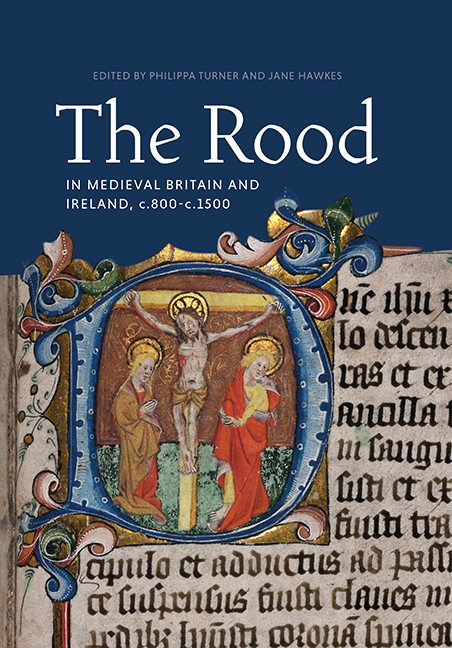Book contents
- Frontmatter
- Contents
- List of Illustrations
- List of Contributors
- Acknowledgements
- List of Abbreviations
- 1 Introduction: Rethinking the Rood
- 2 Approaching the Cross: The Sculpted High Crosses of Anglo-Saxon England
- 3 The Mark of Christ in Wood, Grass and Field: Open-Air Roods in Old English Medical Remedies
- 4 Twelfth-Century English Rood Visions: Some Iconographic Notes
- 5 Crosses, Croziers and the Crucifixion: Twelfth-Century Crosses in Ireland
- 6 From Religious Artefacts to Symbols of Identity: The Role of Stone Crosses in Galician National Discourse
- 7 The Rood in the Late Medieval English Cathedral: The Black Rood of Scotland Reassessed
- 8 The Cross of Death and the Tree of Life: Franciscan Ideologies in Late Medieval Ireland
- 9 Heralding the Rood: Colour Convention and Material Hierarchies on Late Medieval English Rood Screens
- 10 Reframing the Rood: Fifteenth-Century Angel Roofs and the Rood in East Anglia
- Bibliography
- Index
- Already Published
- Plate Section
2 - Approaching the Cross: The Sculpted High Crosses of Anglo-Saxon England
Published online by Cambridge University Press: 07 November 2020
- Frontmatter
- Contents
- List of Illustrations
- List of Contributors
- Acknowledgements
- List of Abbreviations
- 1 Introduction: Rethinking the Rood
- 2 Approaching the Cross: The Sculpted High Crosses of Anglo-Saxon England
- 3 The Mark of Christ in Wood, Grass and Field: Open-Air Roods in Old English Medical Remedies
- 4 Twelfth-Century English Rood Visions: Some Iconographic Notes
- 5 Crosses, Croziers and the Crucifixion: Twelfth-Century Crosses in Ireland
- 6 From Religious Artefacts to Symbols of Identity: The Role of Stone Crosses in Galician National Discourse
- 7 The Rood in the Late Medieval English Cathedral: The Black Rood of Scotland Reassessed
- 8 The Cross of Death and the Tree of Life: Franciscan Ideologies in Late Medieval Ireland
- 9 Heralding the Rood: Colour Convention and Material Hierarchies on Late Medieval English Rood Screens
- 10 Reframing the Rood: Fifteenth-Century Angel Roofs and the Rood in East Anglia
- Bibliography
- Index
- Already Published
- Plate Section
Summary
When considering the ‘Rood’ of the later Middle Ages it is worth perhaps turning to the earliest forms of the monumental crosses that were erected both inside and outside church buildings in Britain and Ireland from the early part of the eighth century onwards. Unique to the region until at least the late eleventh, if not the twelfth century, these large-scale public sculptures have attracted considerable attention for some time, but increasingly so since the early twentieth century.
Given its distinctive ‘free-standing’ form, attempts to explain the emergence of this particular monument type have resulted in the general understanding of it as an innovation reflecting the amalgamation of a number of material cultural phenomena. Among these is the fact that they reflect the reinvigoration of the art of stone sculpture following the re-establishment of the Christian Church in early medieval England during the course of the seventh century when, as Bede records in his Ecclesiastical History, churches began to be constructed in stone and were decorated and furnished with carved stone work. In their design they also seem to represent the influence of earlier, late antique and early Christian monumental forms. These include the stone column, a form that was associated with the triumphal sign of the cross encountered in Constantinian contexts in the early Christian Mediterranean world: as in Jerusalem where a (triumphal) column is recorded as standing close to the Holy Sepulchre complex surmounted by a cross and carved with a Maiestas near the top. Although this monument is unlikely to have been physically encountered by Anglo-Saxons (other than Willibald whose travels to Jerusalem were recorded by the nun Huneberc in the eighth century), the forms of the triumphal and Jupiter column would have been familiar across Europe and in Rome. Together, associations and encounters with the circular columns of antiquity are likely to have informed that of the monumental columns supporting crosses that were set up at the turn of the ninth century in Northumbria and Kent, which also featured the Maiestas in the upper registers. Also influential was the form of the obelisk which is understood to have informed that of the slightly tapering, squared shaft of the high crosses, the obelisk shaft being surmounted by a cross-head in its rearticulated incarnation.
- Type
- Chapter
- Information
- The Rood in Medieval Britain and Ireland, c.800-c.1500 , pp. 15 - 30Publisher: Boydell & BrewerPrint publication year: 2020



